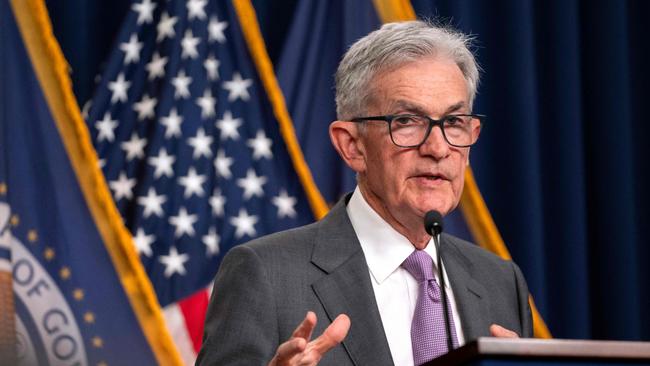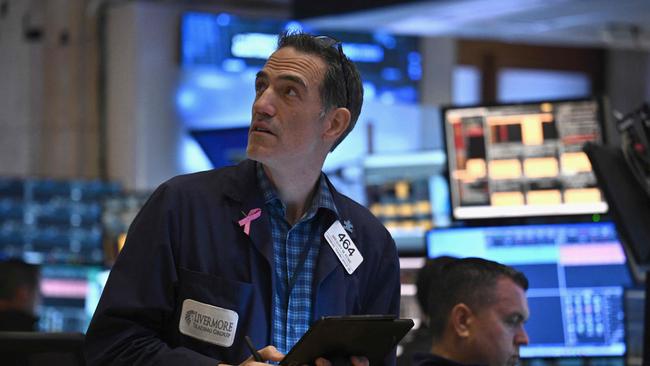Fed’s Powell declares ‘time has come’ for rate cuts
Fed chair Jerome Powell tells closely-watched Jackson Hole summit that the central bank intends to act to stave off labour-market weakening.

Federal Reserve Chair Jerome Powell gave his strongest signal yet that interest-rate cuts are coming soon, saying the central bank intends to act to stave off a further weakening of the U.S. labor market.
“We do not seek or welcome further cooling in labor market conditions,” Powell said in a speech at the central bank’s annual gathering in the Grand Teton National Park on Friday. “The time has come for policy to adjust.” Investors had already been expecting a rate cut in September, but markets still reacted to Powell’s words. Stock indexes rose, with the Dow Jones Industrial Average adding more than 400 points, or about 1.1%. The Nasdaq Composite zipped up 1.5%. Treasury yields slipped.
Powell’s comments Friday all but bring to a conclusion the Fed’s historic inflation-fighting campaign, one that Powell amplified from the same stage two years ago when he signaled his readiness to accept a recession as the price of lowering inflation.
“Chair Powell’s Jackson Hole speech was as clear a pivot toward supporting the labor market as could be imagined,” said Marc Sumerlin, managing partner at economic-consulting firm Evenflow Macro.
Fed officials’ next policy meeting is scheduled for Sept. 17-18. They are widely expected to lower the benchmark federal-funds rate at that meeting.
The Fed held rates steady at its most recent meeting in late July, though several officials saw a case for cutting at that meeting. Two days later, the Labor Department reported that unemployment rose to its highest rate in nearly three years. Inflation, while still above the Fed’s 2% target, has been falling steadily in recent months.
“The cooling in labor market conditions is unmistakable,” Powell said. “We will do everything we can to support a strong labor market as we make further progress toward price stability,” he added.

The key question for financial markets and central bankers -- and one that they themselves don’t yet know the answer to -- is the magnitude of the interest-rate cuts that are coming in mid-September.
The Fed’s key rate is currently set in a range between 5.25% and 5.5%, widely viewed as a drag on economic activity. Market participants are divided as to whether the Fed will shave off 0.25 percentage point or 0.5 percentage point at the September meeting. Investors are also divided on what the Fed will do at its other two meetings this year, in November and December.
While Powell was forceful in laying out the Fed’s goals, he offered no specifics about the precise way officials will deliver them. He entirely avoided certain coded words like “gradual” and “methodical” that some colleagues in recent days had used to describe their expectation for a series of traditional quarter-point rate cuts. In doing so, Powell’s silence kept the door open to larger rate cuts if the labor market shows signs of greater weakness in the weeks ahead.
Fed officials will still get another monthly jobs report, and more readings on inflation, before the September meeting.
Still, by all but promising that a cut is coming, Powell was far less ambiguous than in his press conference after the last Fed meeting, on July 31. At the time, Powell suggested the Fed needed a bit more data to feel confident inflation was coming down. Friday’s speech suggested that he now has that data.
“The direction of travel is clear, and the timing and pace of rate cuts will depend on incoming data, the evolving outlook, and the balance of risks,” Powell said Friday.
The Fed’s actions in the coming weeks and months could be pivotal for the U.S. economy and for Powell, who has served at the central bank since 2012 and was elevated to the top job by President Trump in 2018 and tapped for a second term as chair by President Biden.
Central bankers raised interest rates aggressively in 2022 and 2023, determined to wrestle down the highest inflation in four decades. But the U.S. economy has defied expectations of a slowdown despite the elevated borrowing costs, and inflation came down while the labor market remained historically strong.
The recent rise in joblessness has thrown into question whether that situation will continue. The unemployment rate has risen from 3.4% in April 2023 to 4.3% in July. Inflation, using the Fed’s preferred gauge, was 2.5% in June, its most recent reading.
Powell expressed hope that an elusive “soft landing” for the U.S. economy remains within reach, though he didn’t use the term.
“With an appropriate dialing back of policy restraint, there is good reason to think that the economy will get back to 2% inflation while maintaining a strong labor market,” he said.
--Nick Timiraos contributed to this article.
Write to Paul Kiernan at paul.kiernan@wsj.com
Dow Jones Newswires August 23, 2024 16:30 ET (20:30 GMT) Copyright (c) 2024 Dow Jones & Company, Inc.



To join the conversation, please log in. Don't have an account? Register
Join the conversation, you are commenting as Logout